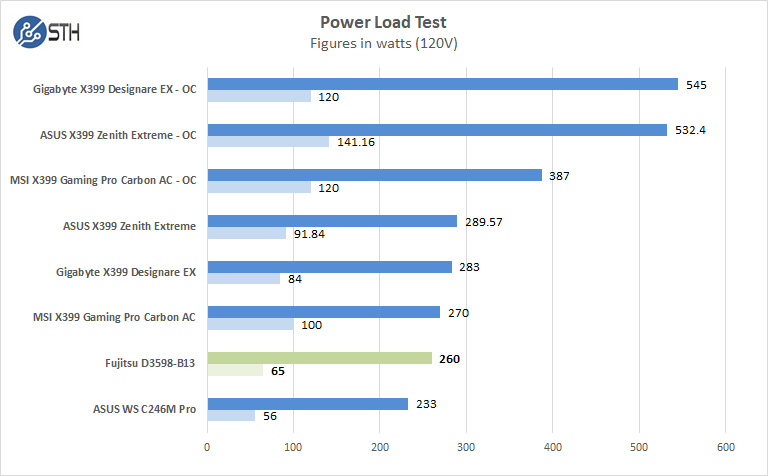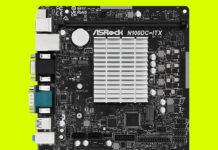Fujitsu D3598-B13 Motherboard Power Consumption
Power consumption can vary a significant amount depending on processors used and the number of HDDs/SSDs/Expansion cards used.

For our tests, we use AIDA64 Stress test which allows us to stress all aspects of the system. The Fujitsu D3598-B13 with Intel Xeon processor W-2123 uses little power, the bulk of the power draw we see is coming from the RTX2060. We were frankly surprised by how little power this system used given the LGA2066 platform.
Final Words
In our tests we found the Fujitsu D3598-B13 to be a great motherboard that provides extra PCIe slots for expansion options, even NVLink for dual NVIDIA Titan RTX GPU’s. With this class of motherboard, quad channel memory configurations are useful for applications that need faster speeds and expanded capacity. With our testing, we installed 8x 16GB memory sticks which gave us a total of 128GB of memory and the Fujitsu D3598-B13 handled this memory load well.
In the industrial motherboard space, the backing of Fujitsu will mean that this motherboard will appeal to a set of customers that needs the company’s support. If you are looking for a gaming motherboard, this will probably do the job however without the typical flash that today’s consumer products have. That is a good thing as it lowers cost, complexity, and the number of controllers that need to be patched in a system. We can see this motherboard pairing well anywhere from workstations to test lab machines to higher-end control applications. Fujitsu does not add unnecessary flair and has some unique features such as the robust SATA ports to differentiate its product in the market.




Are we looking at the same pictures? Where do you see the VGA/DP/HDMI? I see the PS/2 Keyboard/mouse, Red USB, USB C, 2 RJ 45, 6 USB, 3 Audio connectors.
“1x HDMI / 1x DisplayPort / 1x VGA”
That’s the copy/paste quality we expect from STH. Keep up the work!
@hetz. you are rigth. me neither see any of video output. and i have my glasses put on -:)
Fixed, thanks for catching that :)
What a completely lame product. The only thing that stood out is the SATA ports. Literally the rest is copy paste of every other board. They throw in titles like for industrial use without ever even explaining what the true difference is here. Even STH doesn’t go into detail. Everyone tries to prop these type of products up like there’s something good here. It’s the same junk as always but with Fujitsu branding and “support”. As if bare bones and basic is something hard to find. Yeah I’m sure a SuperMicro board wouldn’t be able to do the exact same job because this is somehow special…..The industry is full kf these type of products and people will defend it, as if there aren’t 10000 others available that do the same job. Are they using sooooo much higher “quality” ICs? Caps? Board layers? Nope. Same stuff but sold to you as a “feature”.
All motherboards have the same basic properties but differ in detail. While most consumer boards have tons of additional features they are designed for a moderate usage with a calculated lifecycle of maybe 2 years. Of course, they often last longer but unlikely when they are fully utilized arround the clock for years.
Boards like the Fujitsu are more durable for approved environments (24/7 – 100% utilization up to 50°C!) and have a complete support during the lifecycle (and often extended). This also include BIOS/Firmware patches even years after they reached the market.
So what kind of board you are choosing always depends on your needs.